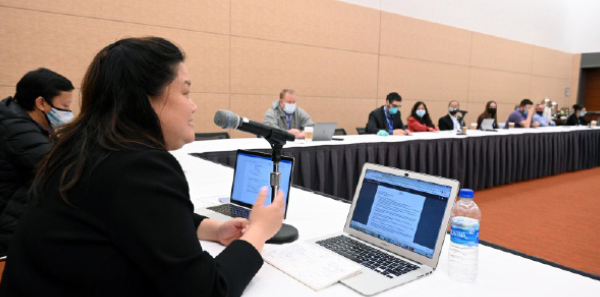
ACEP members often wonder how they can get more involved with the work of the College, especially when it comes to their niche interests or passion projects—clinical topics, advocacy issues, career development, etc. One way to take your involvement to the next level is to get involved with ACEP committees and sections, but this article will focus on committee involvement. If you’ve ever thought about contributing to an ACEP committee, now is the time to do it. Applications are now being accepted through May 15 on our website.
Explore This Issue
ACEP Now: Vol 41 – No 03 – March 2022What’s the Difference Between ACEP Committees and Sections?
ACEP committees are work groups appointed by ACEP’s President-Elect. Committees are assigned objectives through the Board related to the work of the College, including the implementation of Council resolutions. There are 31 committees tackling a broad variety of issues. (See sidebar for the full list.)
ACEP sections have a different structure. ACEP members can elect to join any of ACEP’s 40 sections, so many sections are much bigger than committees. Section membership is a way to network and share information with like-minded peers under the umbrella of specific topics within emergency medicine (EM). Section members who want to go beyond the networking aspect to help set the agenda and goals of the section can get further involved by running for section officer positions. Learn more.

Matthew Gangidine, MD, presents his research as part of the Brooks F. Bock Lecture and Abstract Session during the ACEP21 Research Forum in Boston. The annual Research Forum is organized by ACEP’s Research Committee, and abstracts for the 2022 event are being accepted through May 18 at acep.org/RF.
PHOTOS: ACEP
What Type of Projects Do ACEP Committees Work On?
ACEP committees tackle big topics every year, developing policy statement and other resources to fill gaps and help ACEP members. Here are a few highlights from recent committee efforts:
- The Research Committee oversees ACEP’s annual Research Forum (RF), including the special edition COVID-19 specific forum hosted in 2021. Many of the 2021 RF abstracts are now available on-demand in the ACEP Online Learning Collaborative, and abstracts are now being accepted for the 2022 Research Forum (acep.org/RF).
- The Clinical Policies Committee completed new clinical policies related to community-acquired pneumonia and opioids and is working on policies related to appendicitis, acute heart failure syndromes, and mild traumatic brain injury (acep.org/clinicalpolicies). Revisions to the stroke, sedation, airway management, blunt trauma, pediatric fever, and seizures clinical policies are underway.
- The Federal Government Affairs Committee recently helped ACEP’s advocacy team finalize its legislative and regulatory priorities for the 117th Congress, 2nd session. (See page 3 for more details.)
- The Reimbursement and Coding & Nomenclature Advisory maintain detailed reimbursement FAQs on the ACEP website, and they have just updated them to reflect 2022 changes at acep.org/reimbursement-FAQs. The last physician fee schedule included some complicated but very important policies, and the new FAQs help ACEP members navigate the changes.
- The Academic Affairs Committee organizes ACEP’s popular Virtual Grand Rounds educational events (acep.org/virtualgrandrounds). ACEP members have free access to the live webinars, and the past 17 VGRs are available for on-demand viewing. This committee also recently updated the policy statement “Overcoming Barriers to Promotion of Women and Underrepresented in Medicine (URiM) Faculty in Academic Emergency Medicine,” now available at acep.org/policystatements, along with a Policy Resource and Education Paper (PREP) by the same title.
- The Health Information Technology Committee developed resources to help emergency physicians navigate the “Open Notes” provision in the 21st Century Cares Act, which made ED notes visible to patients via the electronic health record portal (acep.org/healthinfotech). (See page 1 for more details.)
- The EM Practice Committee revised ACEP’s policy statements to strengthen EM scope of practice. Those statements are part of ACEP’s expanded Career Center (acep.org.careercenter).
- The Quality & Patient Safety Committee and the CEDR Committee are heavily involved in the field-testing process for the first EM-specific episode-based cost measure. The committees are reviewing field-testing reports and providing feedback to Acumen, a contractor of the Centers for Medicare & Medicaid Services (CMS), regarding the potential use of this cost measure in the Merit-based Incentive Payment System (MIPS).
- The Communications Committee works with ACEP’s public relations team to fulfill media requests on various topics as part of its efforts to educate the public about the value of emergency physicians. It assisted with a recent bilingual media tour focused on combatting vaccine hesitancy.
- The Medical-Legal Committee produced a six-part webinar series about EMTALA to help ACEP members better understand the law, how it is enforced and how it affects daily practice (acep.org/emtala-webinars).
This is only a small sampling of the way ACEP committees are working year-round to support emergency physicians.
Learn more about how you can get involved and make an even bigger difference at acep.org/committees.
Pages: 1 2 | Multi-Page



No Responses to “ACEP Committees Are Force Multipliers”